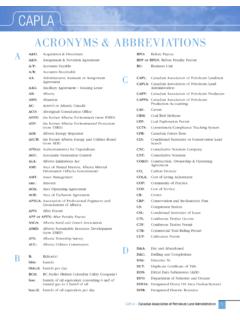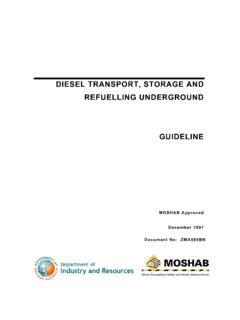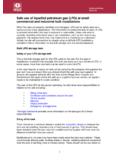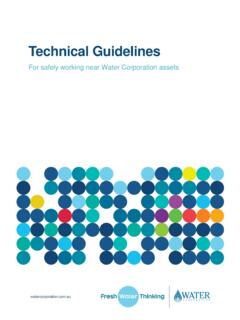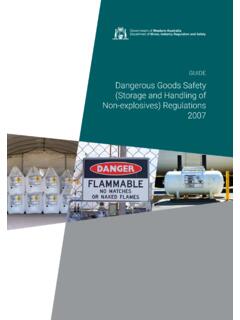Transcription of Third Parties/Crossing - CAPLA
1 Third Parties/Crossing Presentation by Bill Scheers Canadian Association of Petroleum Land Administration Surface Land Administration Advisory Committee November 29, 2011. Agenda EAPUOC Guide for Working Near Buried Facilities . ERCB Directive 066. Alberta Pipeline Act EAPUOC. Guidelines for Working Near Buried Facilities . Overview 1) WORKING NEAR BURIED FACILITIES. The Hazards of Poorly Planned Ground Disturbances 2) CHECKING FOR BURIED FACILITIES. Alberta One-Call 3) THE CROSSING AGREEMENT (MASTER, PROXIMITY, RECIPROCAL). Processing The Crossing Agreement Information Normally Found In the Agreement Guidelines For Facility Drawings Attached To The Crossing Agreement Guidelines for Issuing Safe Work Or Ground Disturbance Permits What Is Working Near Buried Facilities?
2 Any activity that disturbs the ground in the control zone of a buried facility (1 metre on either side of most facilities except pipeline, high voltage power cables and direct bury toll/trunk fiber optic cables where the control zone is 5 metres). Working Near Buried Facilities Include: Blasting Logging Digging Pipe Pushing Ditch Shaping Plowing Pipe or Cable Drilling Removing Buried Facilities or Any Driving Bars Posts Other Activity Which Disturbs or Anchors Rock Picking Driving Over a Subsoil Aeration Parking on Row's Topsoil Stripping Excavation Tree Planting Fire Fighters Cutting Fire Breaks Trenching Grading Tunneling or boring Land Leveling Vertical & Horizontal Auguring Vibrosis What Are Buried Facilities?
3 Any item located below the surface of the ground! These facilities may be privately (landowner) or publicly owned They include: Cables Manholes Catch Basins Pipes Conduits Tanks Culverts Value Chambers (underground storage facilities). Fiber Optics Wires Lines All attachments to these items as well What Are Buried Facilities? These facilities are used for the transmission, distribution, storage or collection of: Cablevision Oil Chemicals Petroleum Products Communications Sewage Electrical Energy Steam Storm Water Natural Gas Water Where Buried Facilities May Be Found An extensive network of buried facilities may be found at depths, ranging from just below the surface to very deep This makes all these facilities susceptible to damage by ground disturbance activities Photo 1: Wire Problems Where Buried Facilities May Be Found These facilities may be found on public or private property, rights of way or easements (buried facilities can be found anywhere at any depth).
4 Photo 2: TransCanada Where Buried Facilities May Be Found In urban areas and on private property, many facilities are within 300mm of the ground surface Street light wires are often just below the sidewalk Communication and electrical duct banks in downtown cores may be just under the asphalt Where Buried Facilities May Be Found The depth of initial cover over buried facilities may be substantially reduced where they have floated in wet areas or due to landscaping, soil erosion or agricultural activity Photo 3: Exposed Pipeline How Can Buried Facilities Be Damaged? Even minor nicks and gouges on pipelines and other buried facilities are serious Corrosion could occur rapidly causing leaks, possible emergency situations, and the interruption of utility and communication services Photo 4: No Dig How Can Buried Facilities Be Damaged?
5 Photo 4: Poor Planning Negligence, sloppy workmanship, lack of awareness, poor planning, or thoughtlessness, may result in severe penalties to those responsible Possible consequences of damaging a buried facility include: Contractor Down Time & Loss of Production Costs to Rehabilitate Injured Workers Damage to Construction Equipment Disruption of Essential Services Environmental Contamination Evacuation of Residential Areas Explosion, Fire, Flood or Toxic Gas Escape Inconvenience to the Public Loss of life Loss of Product and Revenue Personal Injury Third party property damage Possible consequences of damaging a buried facility include: Administration Costs Ambulance, Police, Fire, Costs Costs to Repair Damaged Facility Costs to Rehabilitate Environment Costs to Repair/Replace Construction Equipment Increased Insurance Premiums Increased WCB Assessments Fines and/or Jail Terms Lawsuits and Legal Costs Medical Costs Reduced Credibility With the Public Reduction in Contractors Ability to be Competitive Who Risks Damaging Buried Facilities?
6 Anyone who engages in, or is responsible for a ground disturbance including: homeowners owners of buried facilities farmers consultants ranchers developers contractors provincial departments home builders federal departments landscapers railways equipment operators municipalities Photo 5: Risk Who Risks Damaging Buried Facilities Continued Ground disturbance activity by any of the above groups could result in damage to a buried facility the protection of buried facilities and the safety of workers and the general public, any disturbance of the earth must be considered to be a ground disturbance Typical Pipeline Crossing Flow Chart Photo 6: Stages & Responsibilities in a Typical Crossing CHECKING FOR BURIED FACILITIES.
7 Prior to any work beginning, the ground disturber must establish if any buried facilities exist in the construction area and inform the facility owner(s). Photo 7: Right of Way CHECKING FOR BURIED FACILITIES. Use these sources of information: Pipeline License Register, Energy Resources Conservation Board (ERCB), National Energy Board (NEB). Alberta One-Call Facility Signage or other visible indicators Land Title Deeds Discussion with landowner Municipal Authorities Local utilities Alberta Environment Water Resources Line Locator Sweep/Search Survey, plot plans and any other available maps and references Pipeline License Register Most energy-related pipelines are registered with the Energy Resources Conservation Board (ERCB).
8 Plans showing registered pipelines are available from the ERCB. Phone (403) 297-8311 Calgary toll free 310-0000. Pipeline License Register Federal pipelines that cross provincial boundaries are governed by the National Energy Board (NEB) toll free 1-800-632-1663. Alberta One-Call Alberta One-Call offers a free, computerized service to advise the ground disturber of any one-call member companies that have buried facilities in or near the work area Alberta One-Call will provide a listing of these member companies and will Photo 8: Alberta One advise them of your inquiry Alberta One-Call You are still required to make direct contact with any facility owners who are not members of Alberta One-Call It's your responsibility as a ground disturber to ensure that all facility owners have responded to your locate request Information that Alberta One-Call Requires: Photo 9: Form THE CROSSING AGREEMENT.
9 (MASTER, PROXIMITY, RECIPROCAL). Photo 10: Road Crossing Photo 11: Pipe Crossing Crossing agreements are required by pipeline owners and may be required by other facility owners whose facilities are in a right of way on private land THE CROSSING AGREEMENT. (MASTER, PROXIMITY, RECIPROCAL). Always contact the facility owner for information on whether or not a crossing agreement is required It may take up to 21 days for a facility owner to respond to a crossing agreement request THE CROSSING AGREEMENT. (MASTER, PROXIMITY, RECIPROCAL). The crossing agreement, signed by authorized representatives of both the facility owner and the crossor, must be in effect and on site prior to any work commencing on the right of way THE CROSSING AGREEMENT.
10 (MASTER, PROXIMITY, RECIPROCAL). The first three of the following four sections contain checklists which will assist facility owners with the preparation of the crossing agreement: Processing the crossing agreement Information normally found in a crossing agreement Guidelines for facility drawings attached to the crossing agreement Guidelines for issuing Work Permits THE CROSSING AGREEMENT. (MASTER, PROXIMITY, RECIPROCAL). The guidelines are widely accepted as industry standards Engineering or other special considerations may require some changes in the figures quoted The procedures outlined in these sections should be followed for any work considered by the facility owner to be of a major nature Minor work or simple crossings that involve no excavation may at the discretion of the facility owner, be handled by other forms of agreement Processing The Crossing Agreement A legal land description of the intended crossing must be provided by the crossor before the facility owner can process the crossing agreement Photo 12: Land Description Photo 13: Example Photo 14.
